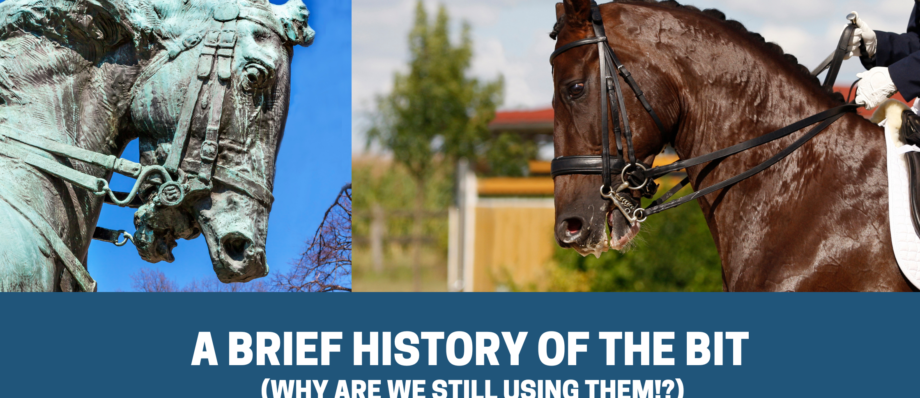A brief history of the bit (why are we still using them!?)
It’s a sad fact that most equestrians bridle their horses without entirely understanding the purpose of the bit, let alone why they are using a specific style of bit, or even how the bit came to be in the first place. When you stop to think about it equines are the only animals we control by placing something in the mouth.
Before the bronze age, bits were made out of bones, rawhide, leather, and horns from animals. This early evidence for the use of bits to control horses comes from and archaeological site in Dereivka, Ukraine where archaeologists have found 5,000 year old equine remains with evidence of bit wear on the second pre molar teeth.
These early materials were not sustainable because the material would often brake or corrode. During the time of the Bronze and iron ages, metal bits started to replace all of the old materials which they were used.

The earliest records of metal bits date from roughly the 14th century BC and were originally made of bronze. These discoveries were made in the region of Luristan, in ancient Mesopotamia present day Iran. Plain and jointed mouthpieces appeared at the same time, often with highly ornamented cheekpieces.
Early mouthpieces were severe, as training of the horses had not developed very far, and riders merely needed a means of control when riding into war.
The need for control over war horses lead to the development of the curb bit with long shanks and often a high port giving the rider much control over the horse with little pressure on the rein.
A roman bit similar to todays Pelham
The leverage of the curb bit applies more pressure on the poll, lips and to the nerve under the jaw. It’s not until the 1700’s that we see ‘milder’ bits start to be introduced as we see more emphasis being placed on training the horse rather than simply controlling them. Over the years horse riding had be recognised as more of an art, however modern versions of the curb bit are still very commonly used today.
Xenophon was an ancient Greek man who wrote the first ever recorded text on horsemanship. The book was focused on the training of horses for warfare, and that is where dressage originated. Xenophon observed horses natural movements – collection, pirouettes, and lateral motion – while they roamed freely in a herd. It was decided that if these manoeuvres could be trained for use in the battlefield, a major strategic advantage would be obtained over those fighting on foot. Modern dressage later evolved as civilians developed the sport, still retaining the classical principles of lightness and impulsion. He understood that training the horse rather than simply controlling them enabled more accurate movements and the ability to be in better overall control of the horses behaviour. Xenophon mandated that the cavalryman must ride with a loose rein. So although the bits were harsh, the intention was that the horse be well trained to commands of the riders body weight and leg aids with the rein used only when necessary. Something that seams to have been forgotten by many of todays riders!
The harsh curb bits we see used by our ancestors became the predecessor to the curbs we have today, while the snaffle evolved to have different cheek pieces and mouth shapes. Today both styles of bits are available in a wide range of sizes, materials and shapes. As our understanding of the equine mouth and dental structure continues to grow it in turn continues to influence bit design and our personal choices of bits for individual horses. At the root, though, many of the bits of today are identical to those found by archaeologists all over Europe and Asia.
Horses today
Today the majority of horses are poorly trained and over bitted with the modern rider being obsessed with using gadgets for a quick fix. We’re putting flash nose bands on them to stop them opening their mouth when a bit causes pain and harsh bits to enable a novice rider to have control. Sadly, too often we use bits as a solution for poor training or riding ability.
It is common when the horse develops a vice or is ‘being naughty’ or ‘misbehaving’ that one of the first things an owner wants to do is change the horses a bit, noseband or use a gadget. That is like putting a plaster on somebody who needs surgery. It just covers up the wound. The problem doesn’t go away, it is hidden and often develops into issues elsewhere ether behaviourally or physically.
What history teaches us about bits is that even thousands of years ago when we introduced bits, it was recognised that they were not the solution. The solution to controlling a horse to do as you ask was training.
We must remember that bits were introduced to control the horse for war. Many of todays equine sports such as eventing, dressage, show jumping and polo were introduced by the military to perfect and display that training.
The solution to producing an obedient horse a long time ago was training and the solution nowadays is training and not just training the horse but training ourselves also.
It is extremely important that riders know how to have soft hands and ride using their whole body. Every rider should have an understanding of what the actions of their hands are doing to the horse. Today we are not riding our horses into war. We do not need to control them in the same way. We need to listen to them and train them with kindness and understanding.





